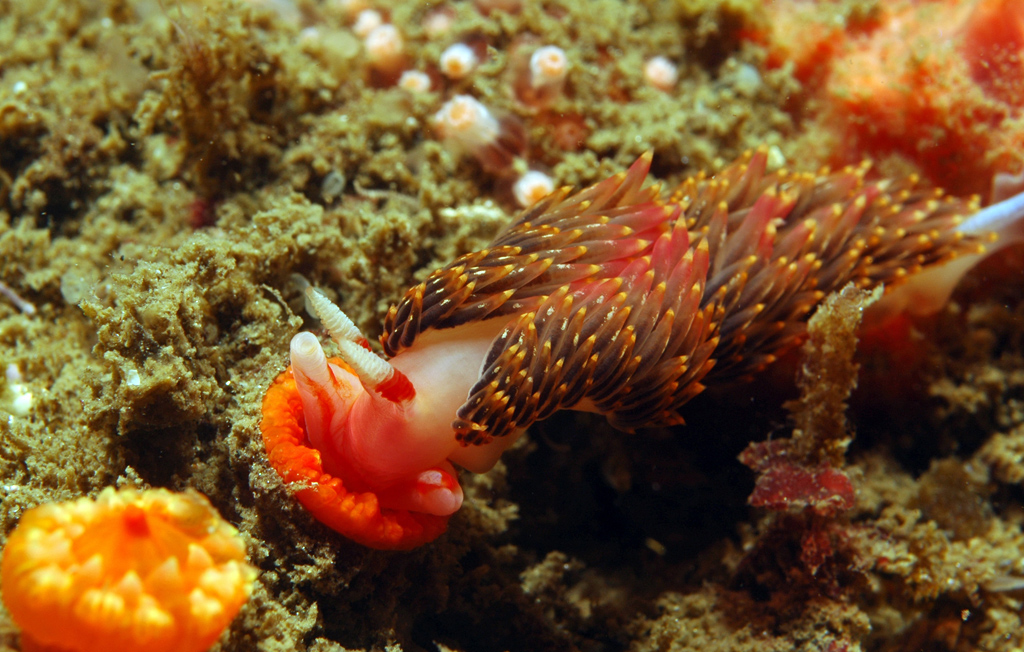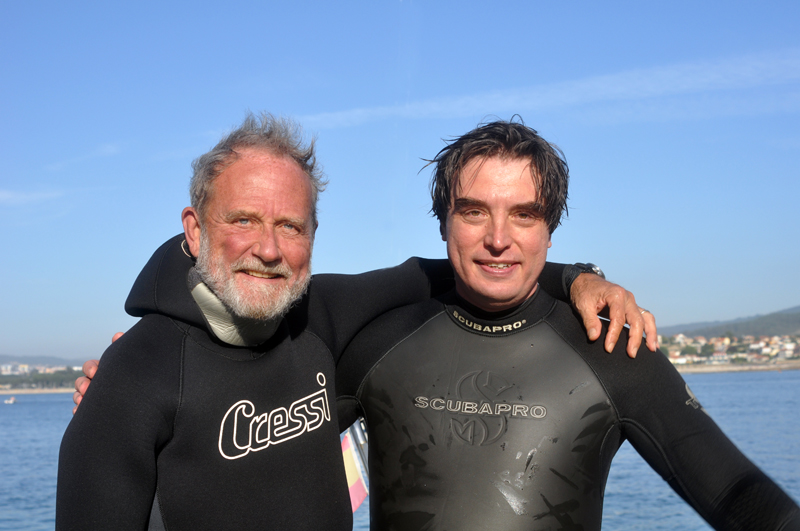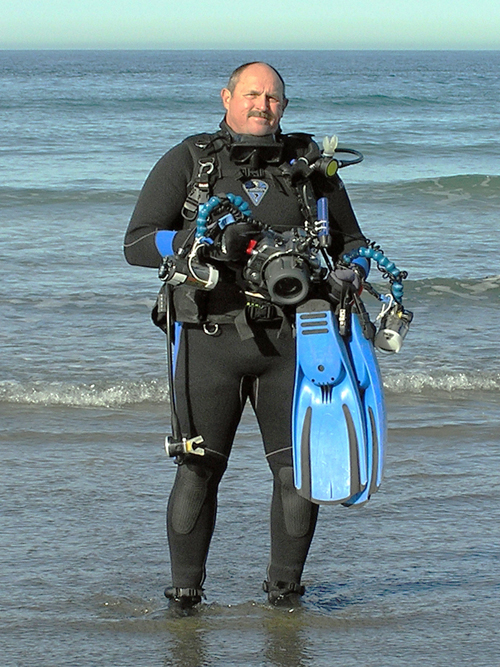 |
Copyright by Tracy Clark 2007
Phidiana hiltoni Eats Stony Corals
Phidiana hiltoni (O’Donoghue, 1927)
This pugnacious, black aeolid occurs from Duxbury Reef, Marin Co., California, to Isla de Cedros, Baja California, México (Behrens & Hermosillo, 2005; Farmer & Collier, 1963). A report of its presence in the Gulf of México (Childs, 1960) is almost certainly erroneous; there have been no other reports of this species outside its amphi-Californian distribution. Both Gary McDonald (pers. comm., 2 December 2010) and I believe Childs’ photo to have been wrongly placed.
A distinctive red line occurs across its front, stretching over the basal halves of the oral tentacles . It has a white body. The yellow-white-tipped rhinophores are encircled by a basal red band and the ceratal cores are quite dark. Its agonistic behavior (even preying on other aeolids in captivity) has been well documented.
O’Donoghue’s rather vague original description was based on a preserved specimen collected at Laguna Beach, California, by Dr. W. A. Hilton. Professor William Atwood Hilton was born 27 June 1878 in Van Etten, Chemung Co., New York. He received his Ph.D. from Cornell University, and as Professor of Zoology with Pomona College, served as Director of the Laguna Marine Biology Laboratory (built in 1913), where he conducted summer sessions for the next 30 years. He died 10 August 1970, as Professor Emeritus.
The synonymy of this species was determined by McDonald (1983: 202-203), primarily based on radular morphology. O’Donoghue (1927: figures 70 and 71) illustrated the mandible and the distinctive radular tooth , . McDonald recognized that the morphology of the radular tooth of his specimen (1983: fig. 109) matched that of O’Donoghue’s Facelina hiltoni and those of Phidiana pugnax Lance, 1962 (Figure 6), and Phidiana nigra (Figure 70 ),( MacFarland, 1966 (Plate 71, figures 17-20)). Based on the radula, similarities in the mandible, gross external anatomy, and their sympatric presence in southern and central California, he synonymized them with O’Donoghue’s earlier-named species. Note that Roller (1970) had already synonymized Lance’s and MacFarland’s species.
Phidiana hiltoni is known to feed on the hydroid Hydractinia (McDonald & Nybakken, 1978). We here present evidence that subtidal specimens prey on stony corals!
Tracy Clark photographed a Phidiana hiltoni eating Balanophyllia elegans Verrill, 1864, off Point Loma, San Diego (see the title picture above), on 19 May 2007. I have seen P. hiltoni in association with B. elegans at Arbolitos , on the south side of Punta Banda, Ensenada, at 45 feet depth (11 February 1984), including one nudibranch alongside two recently eaten Balanophyllia empty cups. Several images of P. hiltoni “in association with Balanophyllia” have been published (Behrens, 1991: 98) or posted on the internet (www.seaslugforum.net/find/phidhilt ).
On 14 November 1982, I observed a 43 mm long Phidiana hiltoni eating another species of solitary coral, Astrangia lajollaensis Durham, 1957, at 39 feet depth, also at Arbolitos, Punta Banda.
These subtidal records of predation by Phidiana hiltoni on stony corals (from northern Baja California and very southern California) can be added to its reported gustatory enjoyment of hydroids!
References
Behrens, David W. 1991. Pacific Coast Nudibranchs, 2nd edition. Sea Challengers, Monterey, California. vi + 107 pp.
Behrens, David W. & Alicia Hermosillo. 2005. Eastern Pacific Nudibranchs. A Guide to the Opisthobranchs from Alaska to Central America. Sea Challengers, Monterey, California. vi + 137 pp.
Childs, T. W. 1980. The silver lining. Oceans Magazine 13 (2): 50-54.
Farmer, Wesley M. & Clinton L. Collier. 1963. Notes on the Opisthobranchia of Baja California, Mexico, with range extensions The Veliger 6 (1): 62-63.
Lance, James R. 1962. Two new opisthobranch mollusks from southern California. The Veliger 4 (3): 155-159.
MacFarland, Frank Mace. 1966. Studies of opisthobranchiate mollusks of the Pacific coast of North America. California Academy of Sciences, Memoirs 6: 1-546.
McDonald, Gary R. 1983. A review of the nudibranchs of the California coast. Malacologia 24 (1-2): 114-276.
McDonald, Gary R. & James R. Nybakken. 1978. Additional notes on the food of some California nudibranchs with a summary of known food habits of California species. The Veliger 21 (1): 110-118.
O’Donoghue, Charles H. 1927. Notes on a collection of nudibranchs from Laguna Beach, California. Journal of Entomology and Zoology (Pomona College Department of Zoology) 19 (1-4): 77-119.
Roller, Richard A. A list of nomenclatural changes for MacFarland’s “Studies of opisthobranchiate mollusks of the Pacific coast of North America.” The Veliger 12 (3): 371-374.
Imperial Beach, Calif
Jan., 2011
Send Hans email at hansmarvida@sbcglobal.net
WEBMASTER'S NOTES(03/20/2011):
Jeff Goddard in association with Terry Gosliner and John Pearce have recently published on the recent range shift of Phidiana hiltoni in California.
The abstract may seen at
Springerlink or seen in it's entirety as a
downloadable PDF file .
 |
 |
Tracy Clark was certified in 1986, a month after being certified he rented a underwatercamera in Hawaii and was hooked. Tracy is a Public Works Lead Worker . He dives mostly San Diego areas, plus a few trips to Hawaii. He has placed in various underwater photo contests.. He has had photos published in magazines and recently tried his hand at writing an article for California Diving News. Tracy was also SDUPS Photographer of the Year in 1999, 2004, 2008, 2009 (shared) and 2010. Picture (above) was taken with a Nikon D-70s, Sea & Sea housing, two Sea & Sea 110 strobes.
You will find Tracy at La Jolla Shores almost every weekend and sometimes on Friday. Send Tracy email at tracyc1@cox.net |
